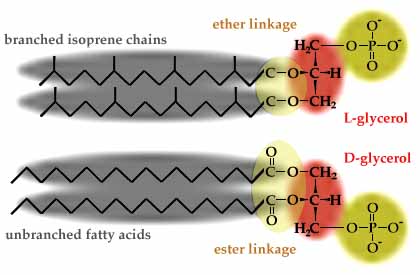 Microbiology Daily Newsletter
Microbiology Daily Newsletter
January 22, 2014 - Archaeal Cell Membranes
Bacteria and Eukarya have a membrane composed of a phospholipid bilayer. The phospholipid is a common lipid, and naturally gathers so that the hydrophobic tails interact with each other and the polar heads face water. The lipid bilayer, seen below, creates a perfect semi-permeable structure by having a hydrophobic layer sandwiched between two hydrophilic layers. NOTE: The lipid bilayer by its self is semi-permeable; once we add proteins, we describe the membrane as selectively permeable (why?).
 |
| Phospholipid Bilyaer: http://en.wikipedia.org/wiki/Image:Lipid_bilayer_section.gif |
Like the Bacteria and Eukarya, the Arachaea have a lipid bilayer, but the composition of the lipids is radically different. What's different? The phospholipids.
- Bacteria and Eukarya use an ester linkage between glycerol and fatty acids, while archaea use an ether linkage.
 |
| Ester Linked Fatty Acids: http://www.uic.edu/classes/bios/bios100/lecturesf04am/phospholipid.jpg |
 |
| Differences between Archaeal Phospholipids (Top) and Bacteria/Eukarya Phospholipids (bottom). http://www.ucmp.berkeley.edu/archaea/esterether.jpg |
- Instead of fatty acids, Archaea utilize isoprenoids as the hydrophobic tails. Unlike straight chain fatty acids, isoprenoid chains have branches, and can include ring structures (cyclopropane and cyclohexane rings are the two most commonly found). You can see an example of a branched isoprenoid chain in the above diagram.
- As can be seen above, the glycerol used by Archaea is an enantiomer of the glycerol used by Bacteria and Eukarya. Archaea utilize L-Glycerol while Bacteria and Eukarya utilize D-Glycerol. Question: can an enzyme that uses D-glycerol use L-glycerol?
- In some Archaea, the membrane is composed of a monolayer instead of a bilayer. In this type of membrane, a long isoprenoid has connects two separate glycerols, each with polar heads. This type of amphipathic molecule is referred to as a bolaamphiphile.
 |
| Archaeal bolaamphiphiles from Ferroplasma acidiphilum. Pivovarova, T. A.; Kondrat'eva, T. F.; Batrakov, S. G.; Esipov, S. E.; Sheichenko, V. I.; Bykova, S. A.; Lysenko, A. M.; Karavaiko, G. I. (2002). Microbiology 71 (6): 698–706. doi:10.1023/A:1021436107979. ISSN 0026-2617. |
Daily Challenge
How would the metabolism of archaeal phospholipids differ from the production of phospholipids in bacteria and eukarya? What would it take to change from the production of archaeal phospholipids to the production of bacterial/eukarya phospholipids? How does this change your understanding of the domains of life and the tree of life?
 Microbiology Daily Newsletter
Microbiology Daily Newsletter



No comments:
Post a Comment